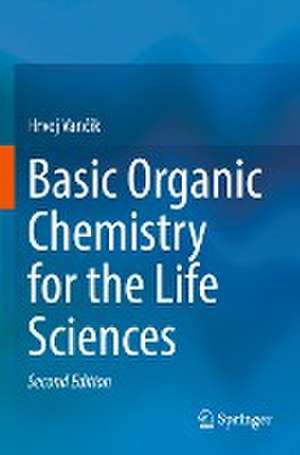Basic Organic Chemistry for the Life Sciences
Autor Hrvoj Vančiken Limba Engleză Paperback – 20 ian 2023
This second edition includes revisions and suggestions made by the readers of the first edition and the author's colleagues. In addition, it includes substantial changes compared to the first edition. The chapter on Cycloaddition has been completed by including the other pericyclic reactions (sigmatropic rearrangements, electrocyclic reactions). The chapter on Organic Natural Products has been extended to include new section covering the principles of organic synthesis. New chapter "Organic Supramolecular and Supermolecular Structures" is added. This chapter covers the basic knowledge about the molecular recognition, supramolecular structures, and the mechanisms of the enzyme catalyzed reactions.
| Toate formatele și edițiile | Preț | Express |
|---|---|---|
| Paperback (2) | 375.34 lei 38-44 zile | |
| Springer International Publishing – 10 sep 2016 | 375.34 lei 38-44 zile | |
| Springer International Publishing – 20 ian 2023 | 459.36 lei 43-57 zile | |
| Hardback (1) | 560.93 lei 43-57 zile | |
| Springer International Publishing – 19 ian 2022 | 560.93 lei 43-57 zile |
Preț: 459.36 lei
Preț vechi: 483.55 lei
-5% Nou
Puncte Express: 689
Preț estimativ în valută:
87.90€ • 92.02$ • 72.73£
87.90€ • 92.02$ • 72.73£
Carte tipărită la comandă
Livrare economică 07-21 aprilie
Preluare comenzi: 021 569.72.76
Specificații
ISBN-13: 9783030924409
ISBN-10: 3030924408
Pagini: 205
Ilustrații: XV, 205 p. 339 illus., 114 illus. in color.
Dimensiuni: 155 x 235 mm
Greutate: 0.32 kg
Ediția:2nd ed. 2022
Editura: Springer International Publishing
Colecția Springer
Locul publicării:Cham, Switzerland
ISBN-10: 3030924408
Pagini: 205
Ilustrații: XV, 205 p. 339 illus., 114 illus. in color.
Dimensiuni: 155 x 235 mm
Greutate: 0.32 kg
Ediția:2nd ed. 2022
Editura: Springer International Publishing
Colecția Springer
Locul publicării:Cham, Switzerland
Cuprins
1. Alkanes, composition, constitution, and configuration.- 2. Functional groups.- 3. Electronic structure of organic molecules.- 4. Alkenes and alkynes.- 5. Substitutions on saturated carbon atom.- 6. Nucleophilic additions.- 7. Stereochemistry, symmetry, and molecular chirality.- 8. Derivatives of carboxylic acids.- 9. Electrophilic substitutions.- 10. Pericyclic reactions.- 11. Organic natural products.- 12. Organic supramolecular and supermolecular structures.
Notă biografică
Hrvoj B. J. Vančik (Varaždin, Croatia, 1952) is professor of chemistry at the Faculty of Science, University of Zagreb, Croatia. His scientific activity comprises the study of organic reaction mechanisms, especially thermally induced reactions in solid-state. Most of his work belongs to the field of vibrational structures of carbocations and solid-state reactions of nitroso and polynitroso compounds. His work in philosophy of science is focused on the theory of complexity in chemistry.
Textul de pe ultima copertă
This textbook is designed for students of biology, molecular biology, ecology,medicine, agriculture, forestry and other professions where the knowledge of organic chemistry plays an important role. The work may also be of interest to non-professionals, as well as to teachers in high schools. The book consists of 13 chapters that cover the essentials of organic chemistry, including - basic principles of structure and constitution of organic compounds, - the elements of the nomenclature, - the concepts of the nature of chemical bond, - introductions in NMR and IR spectroscopy, - the concepts and main classes of the organic reaction mechanisms, - reactions and properties of common classes or organic compounds, - and the introduction to the chemistry of the natural organic products followed by basic principles of the reactions in living cells.
This second edition includes revisions and suggestions made by the readers of the first edition and the author's colleagues. In addition, it includes substantial changes compared to the first edition. The chapter on Cycloaddition has been completed by including the other pericyclic reactions (sigmatropic rearrangements, electrocyclic reactions). The chapter on Organic Natural Products has been extended to include new section covering the principles of organic synthesis. New chapter "Organic Supramolecular and Supermolecular Structures" is added. This chapter covers the basic knowledge about the molecular recognition, supramolecular structures, and the mechanisms of the enzyme catalyzed reactions.
This second edition includes revisions and suggestions made by the readers of the first edition and the author's colleagues. In addition, it includes substantial changes compared to the first edition. The chapter on Cycloaddition has been completed by including the other pericyclic reactions (sigmatropic rearrangements, electrocyclic reactions). The chapter on Organic Natural Products has been extended to include new section covering the principles of organic synthesis. New chapter "Organic Supramolecular and Supermolecular Structures" is added. This chapter covers the basic knowledge about the molecular recognition, supramolecular structures, and the mechanisms of the enzyme catalyzed reactions.
Caracteristici
Second edition of the successful textbook Basic Organic Chemistry for the Life Sciences Especially accommodated mostly for students for which chemistry is not the main profession/discipline Extended and revised edition including the latest advances in the field of organic chemistry
Recenzii
From the book reviews:
“This concise book will be useful for students who need to learn the fundamentals of organic chemistry and how it pertains to biochemistry and biology. … This content is a good primer for those about to take a biochemistry course. … Summing Up: Highly recommended. Lower- and Upper-division undergraduates; professionals/practitioners.” (C. E. Stilts, Choice, Vol. 52 (5), January, 2015)
“This concise book will be useful for students who need to learn the fundamentals of organic chemistry and how it pertains to biochemistry and biology. … This content is a good primer for those about to take a biochemistry course. … Summing Up: Highly recommended. Lower- and Upper-division undergraduates; professionals/practitioners.” (C. E. Stilts, Choice, Vol. 52 (5), January, 2015)
